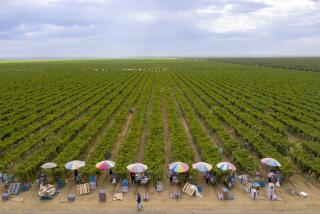Fighting the Chilling Effects
For the second night in a row Wednesday, Orange County strawberry growers were preparing to stay up past midnight in case temperatures fall below freezing as they had the night before.
Below-freezing temperatures, they say, are a major threat to the county’s strawberry crop, worth about $80.5 million a year.
“So far, no one has reported any major damage,” said Rick Lefeuvre, the county’s agricultural commissioner. “Strawberry farmers are pretty sophisticated and they watch the temperatures like a hawk.”
The same appeared true in agriculture-rich Ventura County.
“We dodged a bullet, no question about it,” said Earl McPhail, Ventura County’s agricultural commissioner. That’s not to say it was easy.
After only a few hours’ sleep, Santa Paula citrus and avocado rancher Bob Pinkerton was up at 10 p.m. Tuesday, responding to an alarm warning that the temperature had dropped to 34 degrees in one of his orchards.
He had spent Tuesday afternoon running sprinklers in his groves, a frost-protection measure that can raise the temperature by as much as 4 degrees. Now he had to hop out of bed to fire up his 15 wind machines, a move aimed at circulating the warmer air hovering closer to the ground.
“When that alarm rings, you go,” Pinkerton said. Pinkerton would be at it all night. As the wind machines buzzed overhead, the veteran rancher monitored a series of thermometers staked throughout his orchard.
The temperature would have to drop to 28 degrees or below, for at least a couple of hours, to cause significant crop damage, Pinkerton explained.
By 5 a.m., temperatures were still below freezing. But it had only dropped to 28 degrees once during the night, and then for less than half an hour.
By sunrise Wednesday he was prepared to declare victory, at least for the night. “I think we won,” he said.
Temperatures in some areas of Orange County fell even lower than those in Ventura.
Late Tuesday night, thermometers fell to 26 degrees in some agricultural areas, the lowest in years.
To protect their strawberry crops, Lefeuvre said, most growers turned on sprinkler systems, dousing the berries with a layer of water that freezes and provides them with insulation. “The cold [air] freezes the fruit, which turns black and isn’t marketable,” said Leonel Garcia, manager of Pinnacle Farms, which grows strawberries on about 400 acres in Irvine. “What the sprinkler does is create a coating of ice over the fruit that insulates it from the cold.”
As a result of the action, he said, losses Tuesday night were limited to about 30% of the crop on 10 to 20 acres of land--damage he described as negligible.
But workers would be on hand late Wednesday, he said, to again monitor the temperature.
“We will most likely turn it on again,” he said. “The cold could last another two days and maybe into early next week.”
Other farmers said they were doing the same.
“It’s unseasonably cold,” said Doug Circle, owner of Sunrise Growers of Placentia, “probably the coldest we’ve had in the last five or six years.”
While Tuesday’s low temperatures caused “a big amount of damage” to the February crop, he said, it probably affected less than 5% of the total. The main economic drain, Circle said, was the “huge cost” of people working overtime to monitor the weather, the cost of water for the sprinkler systems and the disruption to the harvesting cycle.
Still, Circle said, the industry would survive. “This is outside the norm, but not unexpected. We’ll get through it because we’re prepared to live with the weather--it’s all part of farming.”
Minor damage was reported in some of the coldest pockets of Ventura County.
More to Read
Sign up for Essential California
The most important California stories and recommendations in your inbox every morning.
You may occasionally receive promotional content from the Los Angeles Times.










